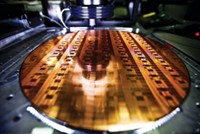Advertisement
Grab your lab coat. Let's get started
Welcome!
Welcome!
Create an account below to get 6 C&EN articles per month, receive newsletters and more - all free.
It seems this is your first time logging in online. Please enter the following information to continue.
As an ACS member you automatically get access to this site. All we need is few more details to create your reading experience.
Not you? Sign in with a different account.
Not you? Sign in with a different account.
ERROR 1
ERROR 1
ERROR 2
ERROR 2
ERROR 2
ERROR 2
ERROR 2
Password and Confirm password must match.
If you have an ACS member number, please enter it here so we can link this account to your membership. (optional)
ERROR 2
ACS values your privacy. By submitting your information, you are gaining access to C&EN and subscribing to our weekly newsletter. We use the information you provide to make your reading experience better, and we will never sell your data to third party members.
Materials
High-k Dielectrics Require New Etching Techniques
by MICHAEL MCCOY, C&EN NORTHEAST NEWS BUREAU
June 27, 2005
| A version of this story appeared in
Volume 83, Issue 26
COVER STORY
High-K Dielectrics Require New Etching Techniques
While one group of companies is hard at work developing new high-k dielectrics, another group is working to come up with semiconductor etching and cleaning chemistries that complement these exotic new materials.
High-dielectric-constant films based on hafnium oxide or hafnium silicate are poised to replace silicon dioxide in the transistors of the next generation of computer chips. An important step in building these transistors is etching away excess dielectric from their source and drain areas.
Jeffery W. Butterbaugh, chief technologist at semiconductor equipment maker FSI International, explains that SiO2 is easily removed with wet-etching baths based on hydrofluoric acid or on HF buffered with ammonium fluoride. Hafnium-based films, in contrast, are frustratingly impervious to the standard HF bath. In industry parlance, standard etchants have poor selectivity to hafnium--they eat away desired chip components like silicon and polysilicon as much as they do hafnium.
In February, FSI received a U.S. patent for a new process based on a very dilute HF-based solution that is applied at elevated temperatures. Developed at the firm's Chaska, Minn., laboratories, the process effectively removes hafnium using existing equipment and has received "considerable interest" from many semiconductor makers, Butterbaugh says.
Honeywell International is taking a different approach, according to Michael Tucker, program manager for Honeywell Electronic Materials' electronic chemicals division. At the company's Chandler, Ariz., labs, scientists have developed a patent-pending solvent that Tucker claims can etch hafnium quickly and effectively--and at near room temperature. Other than a fluorinated compound, he won't say what's in the solvent.
Honeywell's product is intended to be used after dry etching based on ion sputtering has removed some of the unwanted hafnium. Butterbaugh says FSI's technique doesn't require such pre-etching when used on hafnium silicate films, although the technique does require pre-etching when used on wet-etch-resistant hafnium oxide films.
Indeed, although Butterbaugh and Tucker are competitors, they agree that hafnium silicate is an easier dielectric to etch than hafnium oxide. Partly for this reason, Tucker says, the semiconductor industry is gravitating toward hafnium silicate and related compounds, at least as the initial high-k material of choice.
They also agree that the introduction of hafnium-based dielectrics is creating a ripple effect in the world of semiconductor materials. "It's just one layer of the chip," Tucker says, "but that one layer is requiring a significant shift in the types of chemistries needed."





Join the conversation
Contact the reporter
Submit a Letter to the Editor for publication
Engage with us on Twitter